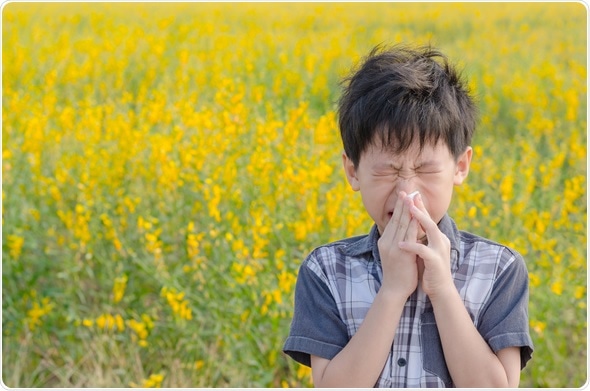Although any child may develop allergies, some children are more likely to be affected than others. For example, children with a family history of allergic reactions are at a higher risk of developing allergies themselves, which suggests a genetic susceptibility.
It is important for parents to be aware of common signs that may be indicative of an allergic reaction in children as this can help to identify allergies and improve the child’s quality of life. These signs may include:
- Frequent sneezing, runny nose, itchy eyes or coughing
- Recurring skin rash or hives
- Difficulty breathing
- Stomach upset, cramps or nausea after eating certain foods

Image Copyright: all_about_people / Shutterstock
Triggers
Certain factors can sometimes trigger an allergic reaction in children. These may include:
- Pollen from trees and plants
- Insect bites or stings
- Animal hair or fur
- Dust mites and mold
- Cigarette smoke or car exhaust
- Peanuts, eggs and milk products
Where possible, it is useful to identify the causative trigger so that it can be avoided or exposure to it can be reduced in the future. For example, the fur from a pet cat may cause allergic symptoms a child so giving the cat away to another home may be a good option. Alternatively, avoiding outdoors during seasons with high pollen count may help people who have allergy triggered by pollen.
Allergic Rhinitis
Allergic rhinitis, also known as hay fever, is the most common type of allergy in children. It causes symptoms such as a runny nose, sneezing, and nasal congestion. The eyes and ears may also be affected by becoming red and itchy.
Nasal congestion can often be caused by allergic rhinitis and makes it difficult for the child to breathe, particularly during the night when they are sleeping. As a result, affected children may sleep poorly and suffer from daytime fatigue. Without treatment, a tendency to breathe through the mouth rather than the congested nose can also lead to abnormal development of the teeth and facial bones.
Allergies can also lead to inflammation and accumulation of fluid in the ear, which can cause recurrent ear infections. In severe cases, this can also interfere with the child’s ability to hear, and impairment may also affect the child’s ability to learn to speak.
It is, therefore, important that the allergies are managed appropriately to reduce the impact of allergic rhinitis and associated complications. This may include avoidance of allergy triggers and medication to reduce the allergic reaction in some cases.
Food Allergies
Food allergies are common among children and infants. Possible trigger foods may include peanuts, milk, eggs, fish, shellfish, soy, tree nuts and wheat.
Occasionally some babies who breastfeed may have a reaction to breast milk when their mother eats certain foods. If this is suspected, the baby can be tested for allergies and the mother may need to avoid certain foods to reduce the child’s exposure to the trigger.
When infants begin to transition to solid foods, it is important that each new food is introduced separately. This helps to identify the causative food if an allergic reaction does occur so that it can be avoided in the future. Foods that commonly cause allergic reactions, such as peanuts, eggs, dairy and wheat should be avoided in the first 12 months of life.
Anaphylaxis is a severe allergic reaction that causes difficulty breathing, reduced blood pressure and shock. As it has the potential to be fatal, all parents who have a child with a food allergy should be aware of the possibility and know how to treat the reaction with epinephrine, if required. Additionally, the school or childcare center should be informed of any allergies that a child has and have a copy of the allergy action plan so that they can deal with a reaction if it occurs.
References
Further Reading
Last Updated: Dec 30, 2022